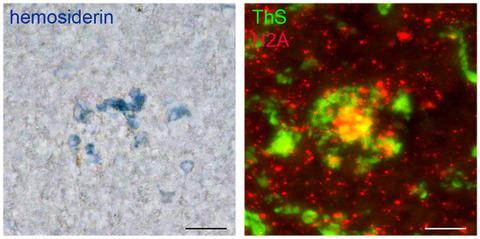当前位置:
X-MOL 学术
›
J. Neurochem.
›
论文详情
Our official English website, www.x-mol.net, welcomes your feedback! (Note: you will need to create a separate account there.)
Distinct brain regional proteome changes in the rTg-DI rat model of cerebral amyloid angiopathy
Journal of Neurochemistry ( IF 4.7 ) Pub Date : 2021-07-04 , DOI: 10.1111/jnc.15463 Joseph M Schrader 1 , Feng Xu 1 , William E Van Nostrand 1
Journal of Neurochemistry ( IF 4.7 ) Pub Date : 2021-07-04 , DOI: 10.1111/jnc.15463 Joseph M Schrader 1 , Feng Xu 1 , William E Van Nostrand 1
Affiliation

|
Cerebral amyloid angiopathy (CAA), a prevalent cerebral small vessel disease in the elderly and a common comorbidity of Alzheimer's disease, is characterized by cerebral vascular amyloid accumulation, cerebral infarction, microbleeds, and intracerebral hemorrhages and is a prominent contributor to vascular cognitive impairment and dementia. Here, we investigate proteome changes associated with specific pathological features in several brain regions of rTg-DI rats, a preclinical model of CAA. Whereas varying degrees of microvascular amyloid and associated neuroinflammation are found in several brain regions, the presence of microbleeds and occluded small vessels is largely restricted to the thalamic region of rTg-DI rats, indicating different levels of CAA and associated pathologies occur in distinct brain regions in this model. Here, using SWATHLC-MS/MS, we report specific proteomic analysis of isolated brain regions and employ pathway analysis to correlate regionally specific proteomic changes with uniquely implicated molecular pathways. Pathway analysis suggested common activation of tumor necrosis factor α (TNFα), abnormal nervous system morphology, and neutrophil degranulation in all three regions. Activation of transforming growth factor-β1 (TGF-β1) was common to the hippocampus and thalamus, which share high CAA loads, while the thalamus, which uniquely exhibits thrombotic events, additionally displayed activation of thrombin and aggregation of blood cells. Thus, we present significant and new insight into the cerebral proteome changes found in distinct brain regions with differential CAA-related pathologies of rTg-DI rats and provide new information on potential pathogenic mechanisms associated with these regional disease processes.
中文翻译:

rTg-DI 大鼠脑淀粉样血管病模型中不同的脑区域蛋白质组变化
脑淀粉样血管病(CAA)是老年人常见的脑小血管疾病,也是阿尔茨海默病的常见合并症,以脑血管淀粉样蛋白聚集、脑梗塞、微出血和脑出血为特征,是导致血管性认知障碍和脑出血的重要原因。痴呆。在这里,我们研究了与 rTg-DI 大鼠的几个脑区特定病理特征相关的蛋白质组变化,这是一种 CAA 的临床前模型。虽然在几个大脑区域发现了不同程度的微血管淀粉样蛋白和相关的神经炎症,但微出血和闭塞的小血管的存在主要局限于 rTg-DI 大鼠的丘脑区域,表明不同水平的 CAA 和相关病理发生在不同的大脑区域在这个模型中。这里,使用 SWATHLC-MS/MS,我们报告了孤立大脑区域的特异性蛋白质组学分析,并采用通路分析将区域特异性蛋白质组学变化与独特牵连的分子通路相关联。通路分析表明肿瘤坏死因子 α (TNFα) 的共同激活、异常的神经系统形态和所有三个区域的中性粒细胞脱粒。转化生长因子-β1 (TGF-β1) 的激活在海马和丘脑中很常见,它们共享高 CAA 负荷,而独特地表现出血栓形成事件的丘脑还显示出凝血酶的激活和血细胞的聚集。因此,
更新日期:2021-07-04
中文翻译:

rTg-DI 大鼠脑淀粉样血管病模型中不同的脑区域蛋白质组变化
脑淀粉样血管病(CAA)是老年人常见的脑小血管疾病,也是阿尔茨海默病的常见合并症,以脑血管淀粉样蛋白聚集、脑梗塞、微出血和脑出血为特征,是导致血管性认知障碍和脑出血的重要原因。痴呆。在这里,我们研究了与 rTg-DI 大鼠的几个脑区特定病理特征相关的蛋白质组变化,这是一种 CAA 的临床前模型。虽然在几个大脑区域发现了不同程度的微血管淀粉样蛋白和相关的神经炎症,但微出血和闭塞的小血管的存在主要局限于 rTg-DI 大鼠的丘脑区域,表明不同水平的 CAA 和相关病理发生在不同的大脑区域在这个模型中。这里,使用 SWATHLC-MS/MS,我们报告了孤立大脑区域的特异性蛋白质组学分析,并采用通路分析将区域特异性蛋白质组学变化与独特牵连的分子通路相关联。通路分析表明肿瘤坏死因子 α (TNFα) 的共同激活、异常的神经系统形态和所有三个区域的中性粒细胞脱粒。转化生长因子-β1 (TGF-β1) 的激活在海马和丘脑中很常见,它们共享高 CAA 负荷,而独特地表现出血栓形成事件的丘脑还显示出凝血酶的激活和血细胞的聚集。因此,


























 京公网安备 11010802027423号
京公网安备 11010802027423号